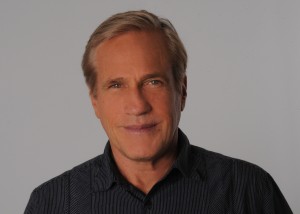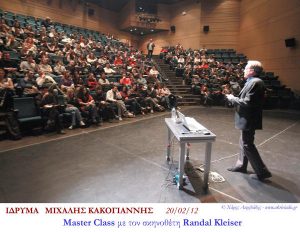
Tell us about the experience you had from your recent stay in Athens.
I was greeted by one of the most efficient and pleasant staff members I’ve met, Alexandra Georgopoulou from the Michael Cacoyannis Foundation. She took me to the Foundation headquarters and I was extremely impressed by the facilities. I stayed at the Divani Palace Acropolis and had a wonderful dinner with the owners. They put me in an amazing suite that had an outdoor deck that looked up on the Acropolis. When photographic artist Dimitris Yeros came to do a shoot, I asked to be photographed on that beautiful deck.
The Master class was the longest I had ever done and I prepared for weeks. Being onstage for five hours was exhilarating. Everyone at the Cacoyannis Institute was supportive and friendly. It was a great experience.

I heard nothing but good reactions. When I give presentations I can sense if the audience is with me, and these students and professionals didn’t fall asleep once during my five hour seminar.
You had also visited Greece a few year back for doing some filming. What lead you to the decision to do some of the shooting there? Have you visited Greece since then?
The movie I shot on the Greek islands was “Summer Lovers” in 1981. During the publicity tour for “The Blue Lagoon,” one of the journalists told me about Santorini and the thousands of young people who flock there each summer. I decided to go there and check it out. I was overwhelmed by the unusual beauty and the social interaction. That led to me writing the screenplay and then returning to film the movie. I did return to Santorini in the 90’s to scatter the ashes of my friend, Harry Stein, who the movie “It’s My Party” was based on.
Although you started directing mainstream Hollywood movies, like the famous musical “Grease,” you decided to go your own way, and to be engaged in more personal projects. How difficult is it for a director in Hollywood to take another route and work as an independent filmmaker?
It’s much more difficult to go independent, but more satisfying. Unfortunately, the Hollywood Studios are only making sequels, remakes, and comic books. They have abandoned midsize performance films with original stories. Those projects are now either made independently or are on American TV. Working for the studios is good money, but you end up being a pawn moving around a cold chessboard.
‘Grease’ is considered to be one of the most successful musicals of all time, that influenced and still influences a lot of people. Tell us if you have any memorable events from the days shooting the movie.
When the soundtrack was being decided, I felt the music should all be from the 1950’s or at least have that sound. Producer Robert Stigwood hired Barry Gibb to write the title song. When I got the demo of the song, I didn’t like the lyrics. They were dark and tough and definitely had nothing to do with the picture we were making.
Stigwood was shooting GREASE and SGT PEPPER’S LONELY HEARTS CLUB BAND at the same time. Our picture was considered the small unimportant teen musical, and SGT. PEPPER was the project everyone was convinced was going to be the critically acclaimed major hit. Barry Gibb was starring in it and I went to the set to discuss the lyrics. He was about to do a big production number and I asked to talk to him. We went behind some flats to talk privately.
[I said,] “You see, Barry, you haven’t seen any of our footage, but we’re making a very light sunny musical. You have written, ‘Life is a time of illusion, wrapped up in trouble and laced in confusion. What are we doing here?’ These lyrics don’t really work for our movie; there’s no trouble, no confusion. It’s not like a film noir. There aren’t any serious scenes. It’s like a happy-go-lucky thing, so, do you think you could change the lyrics?”
He replied, “Why don’t you shoot a serious scene so the lyrics will work.”
When I realized he wasn’t kidding I staggered off the set in shock. The lyrics stayed, the song was a hit, and no one ever noticed they were completely wrong. My introduction to the music world was very confusing.
Tell us a little bit about the Nina Foch course that is addressed both to filmmakers and actors.
Nina Foch was the best teacher I ever had and I knew her teachings had to be recorded for future generations. Even as she continued acting in film and television, her passion for teaching lasted for over forty years. Her course was immensely popular because she developed her own unique style drawing from her experiences studying with Lee Strasberg, Stella Adler and Uta Hagen, as well as, the directors, Vincente Minnelli, Stanley Kubrick, Cecil B. DeMille and Otto Preminger. She taught a generation of filmmakers including John McTiernan, Amy Heckerling, Ed Zwick, Ron Underwood, and many others. Nina went from being my teacher, to my mentor, to my good friend. She often said her greatest accomplishment was her teaching. As she put it, her action was “To share the fascination.” As I began directing, the tremendous value of her teachings became evident. I realized how important it was to preserve them, and I began documenting her classes at regular intervals. My former classmate, George Lucas, put up the financing to shoot a whole semester of her teaching and the 2 set DVD “the Nina Foch Course for Filmmakers and Actors” is the result.

I was hired by Disney Studios to direct Flight of the Navigator. My brother Jeff had been on the cutting edge of computer graphics since they were first done in the late seventies. He kept me updated on what the state of the art technology was. I read a book called “Special Effects” and it had a chapter on the future of Effects. It showed a chrome dog that was created by wrapping the background visual information onto a wire frame computer rendering of a toy dog. It appeared to be three-dimensional and mirrored. I had the idea that this could be done with a moving spaceship…using a computer to “wrap” the background onto a wireframe of the spaceship, which would create an apparently solid mirrored shape. The experiment worked, and James Cameron used the technology later in Terminator II. Jeff helped me with the effects on several other films, including “Honey, I Blew Up the Kid.”
You also invented Vistarama HD and developed Silver Metal Lover for Dimension Pictures. Give us some info about that.
Vistarama HD is a digital filming, warping and projection process that is suitable to the creation and display of content with an expansive field of view. The process recreates for the audience the original field of view of the camera, producing an immersive experience. Similar techniques include Cinerama and IMAX. Both Cinerama and IMAX require large and heavy cameras and film. Vistarama HD uses a single standard digital video camera equipped with a wide angle lens, such as a fisheye. The image is warped to project onto a large curved screen. The unwarped image is displayed via three video projectors onto a 10ft tall, 150 degree screen. In the areas where the three projections overlap, the pixels are blended together to produce a seamless image.
“Silver Metal Lover” is a novel I would love to adapt for the screen. It is currently owned by the Weinstein company.
What are the projects you are working on?
It’s bad luck to talk about movies that have not been greenlit, but I have a comedy, a teen thriller, a sci-fi and a period classic all ready to shoot. Know anyone who wants to invest?
Original photo from seminar taken by Haris Akriviadis
See all the latest news from Greece and the world at Greekreporter.com. Contact our newsroom to report an update or send your story, photos and videos. Follow GR on Google News and subscribe here to our daily email!



